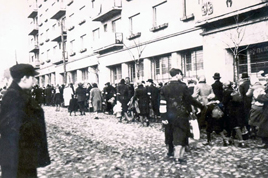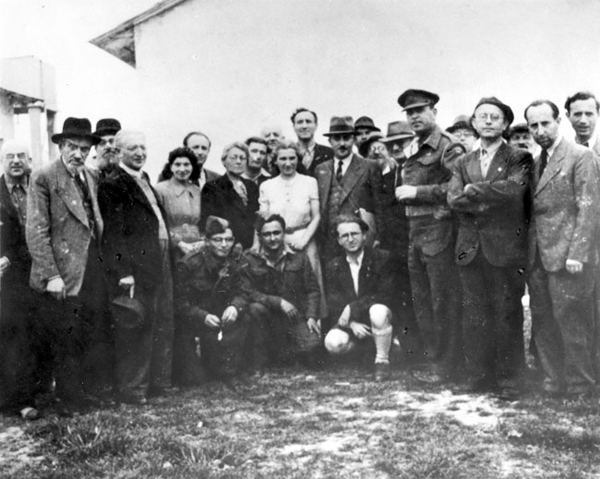First they came for the Jews
and I did not speak out
because I was not a Jew.
Then they came for the Communists
and I did not speak out
because I was not a Communist.
Then they came for the trade unionists
and I did not speak out
because I was not a trade unionist.
Then they came for me
and there was no one left
to speak out for me.
— Friedrich Gustav Emil Martin Niemöller (1892-1984)
It is very hard to convey the immediacy of historical events, to explain that three generations are but a nanosecond in historical terms. With no historical context, it is even harder to prove that human events are cyclical or, as the saying goes*, ‘Those who cannot remember the past are condemned to repeat it”.
The challenge posed before institutions like Yad Vashem The Holocaust Martyrs’ and Heroes’ Remembrance Authority, is to create educational materials that can make relatable events that happened not so long ago.
This Month in Holocaust History is an online presentation of informative texts and archival photos describing events that occurred each month during the Holocaust. In recognition of Yom HaShoah/Holocaust Memorial Day in Israel, we look back at April in Holocaust history with a selection of photos and texts from the Yad VaShem project.
But first, some context. According to Wikipedia, “In 1922 and early 1923, Hitler formed two organizations that would grow to have huge significance. The first was the Jungsturm and Jugendbund, which would later become the Hitler Youth. The other was the Stabswache, an early incarnation of what would later become the Schutzstaffel (SS)… A pivotal moment came when Hitler led the Beer Hall Putsch, an attempted coup d’état on 8–9 November 1923″.
“Hitler was convicted and on 1 April sentenced to five years’ imprisonment [where he] received friendly treatment from the guards; he had a room with a view of the river, wore a tie, regular visitors to his chambers, was allowed mail from supporters and was permitted the use of a private secretary. The Bavarian Supreme Court issued a pardon and he was released from jail on 20 December 1924… Hitler used the time in Landsberg Prison to consider his political strategy and dictate the first volume of Mein Kampf…”
“…in March 1933, after the Reichstag adopted the Enabling Act of 1933 in that month; president Paul von Hindenburg had already appointed Hitler as Chancellor on 30 January 1933 after a series of parliamentary elections and associated backroom intrigues. The Enabling Act—when used ruthlessly and with authority—virtually assured that Hitler could thereafter constitutionally exercise dictatorial power without legal objection”.
April 1927 – A vandalized synagogue in Munich, Germany
In 1922 the Nazi Party was established in Munich. Earlier, in 1920, the head of the Bavarian government sought to deport the Jews from the state, yet in the end was unsuccessful. In 1923 an order was promulgated to deport 180 Jewish families of Eastern European descent. On the Jewish holiday of Sukkot 1923, the windows of the Great Synagogue were vandalized, and Jews in a different synagogue were beaten by a mob.
In 1933, with the rise of the Nazis to power in Germany, about 9,000 Jews lived in Munich, approximately 1.2% of the city’s total population. They held public roles in the city’s economic, social and cultural life. The city had two synagogues – one of which was the Great Synagogue, built in 1884-1887 – as well as other smaller prayer houses. Dozens of Jewish organizations were active in the city, in the religious, educational, cultural, social and political spheres.
The Great Synagogue in Munich was the first synagogue in Germany to be destroyed the Nazis. Hitler visited the city in June 1938 and ordered the destruction of the synagogue… A few hours before the order was carried out, the heads of the Jewish community were officially given notice of the plans. Many members of the Jewish community worked throughout the night in order to remove the Torah scrolls and ritual objects from the synagogue.
The municipality only reimbursed the Jewish community for approximately one seventh of the value of the synagogue and the neighboring Jewish community building.
April 1, 1933 – SA members standing outside of a Jewish-owned store in Berlin during the boycott against Jewish businesses
The boycott of April 1, 1933 against the Jews was the first nationwide act carried out by the Nazis against Germany’s Jews after rising to power some two months beforehand. The boycott was announced as a Nazi response to the “horrible propaganda” spread by world Jewry against the Nazi regime.
The boycott was the first step in the process of destabilizing the economic foundations of German Jewry. A week after the boycott the first national laws were passed against the Jews, aimed at removing the Jews from the public service. Later on most German Jews were removed from their jobs and occupations.
From Wikipedia: “The Second World War is generally said to have begun on 1 September 1939 with the invasion of Poland by Germany and subsequent declarations of war on Germany by France and the United Kingdom. From late 1939 to early 1941, in a series of campaigns and treaties, Germany conquered or controlled much of continental Europe, and formed the Axis alliance with Italy and Japan. Following the Molotov–Ribbentrop Pact, Germany and the Soviet Union partitioned and annexed territories of their European neighbours, including Poland, Finland and the Baltic states. The United Kingdom and the British Commonwealth were the only Allied forces continuing the fight against the Axis…”
The United States ended its isolationist stance and entered the war after the Japanese bombed the American fleet in a surprise attack on Pearl Harbor, Hawaii, on December 7, 1941.
April 1941 – Deportation of Jews from Oswiecim to the Bendzin Ghetto, Poland
Oswiecim was a city of 12,000 residents, almost half of whom were Jews. The Jewish community was very active in the political, cultural and educational realms.
In April 1941 the Germans ordered that the Jews leave Oswiecim for other cities in Silesia, particularly Sosnowiec and Bendzin. During the deportation the Jews were allowed to bring some of their belongings. Some rented wagons upon which they loaded their possessions. The deportation lasted for seven days, after which the Jewish community of Oswiecim ceased to exist. During the deportations of the summer and autumn of 1942, the Jews of Oswiecim were sent, along with the Jews of the ghettos where they had been deported, to the death camps.
Outside of Oswiecim the Germans built Auschwitz, the complex of death and labor camps in which more than 1 million Jews, one hundred thousand Poles, tens of thousands of Russians, gypsies, and others were murdered.
April 1941- A group of German Jewish women in the Gurs prison camp, France
The Gurs prison camp was situated in southern France, in the region controlled by the Vichy regime, the French government that collaborated with Nazi Germany.
In October 1940, four months after France surrendered to Germany, Germany deported 7,500 German Jews to Gurs. From November 1940 to August 1942, approximately 2,000 Jews were released from Gurs, who managed to leave France by sea. Because of the primitive sanitary conditions in the camp, more than 1,100 Jews perished in Gurs.
In August 1942 the deportation of Jews from Gurs to Auschwitz and Sobibor via Drancy began. In December 1943, 48 Jews remained in Gurs. The camp was liberated in August 1944.
Late 1943 and early 1944 was a turning point for the Allies. On September 8, 1943, the Italians surrendered to the Allies. In April 1944, Allied bombers hit German-occupied Budapest, Hungary, and Bucharest, Romania, ahead of the advancing Red Army. General Charles de Gaulle took command of the Free French forces and the Soviet forces liberated the Crimea. The heavy Allied bombings of the European continent would continue through May in advance of D-Day on June 6, 1944.
April 1944 – Visit of Moshe Sharett in the Ferramonti di Tarsia DP Camp, Italy
In June 1940 the Italians established the Ferramonti di Tarsia concentration camp in Southern Italy.
In September 1943, on the eve of the Italian surrender to the Allies, the Italians decided to release the prisoners in the camp, and the camp was converted into a DP camp. Shortly thereafter Jewish soldiers serving in the British Army arrived in the camp and met the 2,000 Jews living there. The Jews in the DP camp established educational institutions and synagogues, as well as branches of the Zionist parties and youth movements.
Moshe Sharett, the head of the Jewish Agency’s Political Department, visited the Ferramonti di Tarsia Displaced Persons’ Camp in Italy in April 1944.
A year later, April 1945, was a critical moment. On April 4, the United States Army liberated the Ohrdruf extermination camp in Germany, the first Nazi concentration camp to be liberated. On April 11, the Buchenwald concentration camp was liberated by the American troops, and on April 15, Bergen-Belsen was liberated by British and Canadian forces.
April 1945 – A pile of shoes belonging to prisoners who perished in Bergen-Belsen, Germany
Originally designed as a prisoner of war and transit camp, Bergen-Belsen was designed to hold 10,000 prisoners. The week before the camp was liberated, the camp had approximately 41,000 prisoners. Some 35,000 to 40,000 inmates died in Bergen-Belsen of starvation, overcrowding, hard labor and disease or were killed. On April 15, 1945, the British Army liberated Bergen-Belsen.
On April 28, former Italian Fascist dictator Benito Mussolini and his mistress, Clara Petacci, were executed by Italian partisans as they attempted to flee the country. Two days later, on April 30, Adolf Hitler and his wife of one day, Eva Braun, committed suicide as the Soviet Red Army approached the Führerbunker in Berlin.
April 1945 – Soldiers of the Jewish Brigade standing guard over German prisoners in Italy
Appearing in the photograph are soldiers of the Jewish Fighting Brigade of the British Army standing guard over German soldiers captured in battle in the vicinity of the Senio River on the Italian front in April 1945.
The Jewish Brigade was established in September 1944 in response to pressure on the British authorities from the Jewish community in Eretz Israel to create a distinct unit for Jews in the army. Approximately 25,000 Jews from Eretz Israel had already been serving within the ranks of the British Army. The soldiers of the Brigade sought to fight and serve on the front… Approximately 5,000 Jews from Eretz Israel served in the Brigade. 57 fell in combat.
After the war the soldiers of the Brigade arrived in different locations throughout liberated Europe where Holocaust survivors had gathered. They were often the first representatives of the Jewish community in Eretz Israel to establish contact with the survivors. They provided the Holocaust survivors with food and medical assistance, and helped many of them cross international borders in order to eventually join the illegal immigration movement for Eretz Israel.
For more images and information about this and other months in Holocaust history, visit the Yad VaShem website.
*Attributed to George Santayana





















